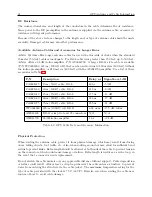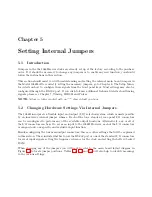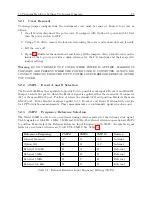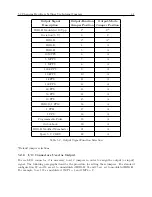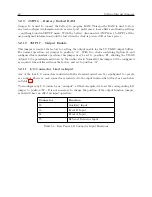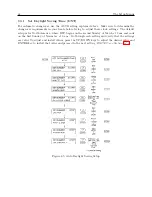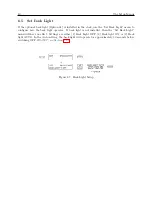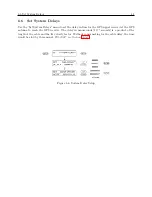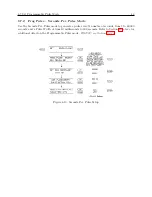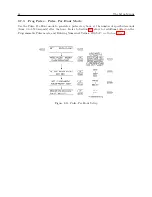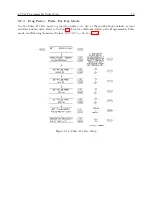
30
Setting Internal Jumpers
5.2.4
JMP3
−
External Reference Input Frequency
Used in conjunction with Jumper 2 in setting up an external reference signal to replace the Model
1088B internal clock. Four choices are available: “A”
−
10 MHz, “B”
−
5 MHz, “C”
−
1 MHz and
“D”
−
100 kHz. If you are going to apply an external reference signal, make sure to read details
of JMP2 above. See Table 5.1.
5.2.5
JMP4, JMP7, JMP10, JMP13
−
Output Function Selection
Jumpers JMP4, JMP7, JMP10, and JMP13 determine the output signals, which can be made
available at I/O connectors J2, J3, J4, and J5, respectively. Figure 5.1 illustrates the relationship
between these jumpers and the I/O connectors (the position of some jumpers is slightly different
in the Model 1088A). The first step in setting an I/O channel for a specific output signal is to
move the associated jumper to the location corresponding to the desired signal. Table 5.2 lists the
jumper settings required for various signals. JMP5, JMP8, JMP11 and JMP14 (located at the top
of the columns of Output Function jumpers) refer to the two analog signals available from setting
jumper positions 1 and 2. They will not be referred to in the setup, but listed for your information.
5.2.6
JMP5, JMP8, JMP11, JMP14
−
Output Function Selection
These jumpers are essentially the same as JMP13, JMP10, JMP7 and JMP4 (in that order),
however they exist because they were used to signify the difference between digital signals and
analog signals. Jumpers 5, 8, 11 and 14 are designated for analog signals, Jumpers 4, 7, 10 and 13
as digital signals.
5.2.7
JMP6, JMP9, JMP12, JMP15
−
Output Mode Selection
The next step in configuring the I/O connectors is to determine whether the assigned signal is an
analog output, a digital output, or an input (configuring the connectors as inputs is described later
in this chapter) . Select the output mode by setting jumpers JMP6, JMP9, JMP12, and JMP15 to
the appropriate positions. These jumpers correspond to connectors J2, J3, J4, and J5, respectively
(see Figure 5.1). If the I/O channel is to be used as a digital output, the corresponding jumper
should be set to position “A”. If the I/O channel is to be used as an analog output, the jumper
should be set to position “C”. Table 5.2 lists jumper positions for individual output signals.
Summary of Contents for 1088A
Page 4: ...iv ...
Page 6: ...vi ...
Page 18: ...xviii LIST OF FIGURES ...
Page 23: ...1 4 Attaching Rack Mount Ears to 1088A B Series Clocks 3 Figure 1 2 Attaching Rack Mount Ears ...
Page 24: ...4 Unpacking the Clock ...
Page 32: ...12 Front and Rear Panels ...
Page 38: ...18 Connecting Inlet Power Input and Output Signals ...
Page 46: ...26 GPS Antenna and Cable Information ...
Page 48: ...28 Setting Internal Jumpers Figure 5 1 Model 1088B Main Board ...
Page 76: ...56 The Setup Menus ...
Page 112: ...92 Serial Communication and Command Set ...
Page 127: ...B 4 Physical Dimensions 107 Figure B 1 Suggested Mounting of the AS0094500 Surge Arrester ...
Page 128: ...108 Using Surge Arresters ...
Page 145: ...C 5 Option 04 Parallel BCD Output 125 Figure C 4 Option 04 Output Jumper Settings ...
Page 146: ...126 Options List Figure C 5 Option 04 Board Layout and Jumper Locations ...
Page 166: ...146 Options List Figure C 12 Option 17 Board Layout and Jumper Locations ...
Page 187: ...C 16 Option 20A Four Fiber Optic Outputs 167 Figure C 22 Option 20A Jumper Locations ...
Page 194: ...174 Options List Figure C 24 Option 23 Internal Jumper Setup ...
Page 196: ...176 Options List Figure C 25 Option 27 Jumper Locations ...
Page 214: ...194 Options List Figure C 28 Option 29 Connector Signal Locations ...
Page 270: ...250 Options List ...









